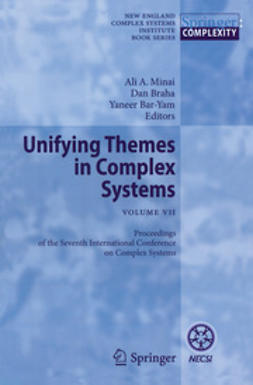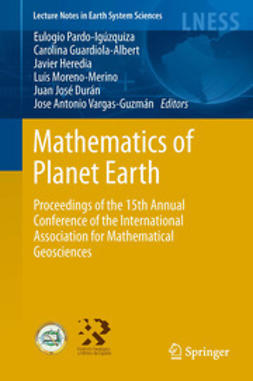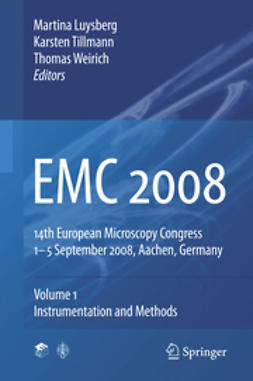Minai, Ali
Unifying Themes in Complex Systems
Part I:. Methods
1. Emergence, Intrinsic Structure of Information, and Agenthood
Daniel Polani
2. Deep and Broad are the Laws of Emergence?
Susan Sgorbati, Bruce Weber
3. On an irreducible theory of complex systems
Victor Korotkikh, Galina Korotkikh
4. Measuring and Tracking Complexity in Science
Jacek Marczyk, Balachandra Deshpande
5. Data-Driven Modeling of Complex Systems
Val K. Bykovsky
6. Modelling Complex Systems by Integration of Agent-Based and Dynamical Systems Models
Tibor Bosse, Alexei Sharpanskykh, Jan Treur
7. On Elementary and Algebraic Cellular Automata
Yuriy Gulak
8. Dual phase evolution — a mechanism for self-organization in complex systems
David G. Green, Tania G. Leishman, Suzanne Sadedin
9. A new measure of heterogeneity of complex networks based on degree sequence
Jun Wu, Yue-Jin Tan, Hong-Zhong Deng, Da-Zhi Zhu
10. Are technological and social networks really different?
Daniel E. Whitney, David Alderson
11. Evolutional family networks generated by group-entry growth mechanism with preferential attachment and their features
Takeshi Ozeki
12. Estimating the dynamics of kernel-based evolving networks
Gábor Csárdi, Katherine Strandburg, László Zalányi, Jan Tobochnik, Péter érdi
13. Consensus Problems on Small World Graphs: A Structural Study
Pedram Hovareshti, John S. Baras
14. Complex Knowledge Networks and Invention Collaboration
Thomas F. Brantle, M. Hosein Fallah
15. Complexity, Competitive Intelligence and the “First Mover” Advantage
Philip Vos Fellman, Jonathan Vos Post
16. Mobility of Innovators and Prosperity of Geographical Technology Clusters: A longitudinal examination of innovator networks in telecommunications industry
Jiang He, M. Hosein Fallah
17. Adaptive capacity of geographical clusters: Complexity science and network theory approach
Vito Albino, Nunzia Carbonara, Ilaria Giannoccaro
18. Corporate Strategy an Evolutionary Review
Philip V. Fellman
19. Towards an evaluation framework for complex social systems
Diane M McDonald, Nigel Kay
20. Operational Synchronization
Kevin Brandt
21. The Complexity of Terrorist Networks
Philip Vos Fellman
22. Complexity Studies and Security in the Complex World: An Epistemological Framework of Analysis
Czeslaw Mesjasz
23. Complexities, Catastrophes and Cities: Emergency Dynamics in Varying Scenarios and Urban Topologies
Giuseppe Narzisi, Venkatesh Mysore, Jeewoong Byeon, Bud Mishra
24. Systems Biology via Redescription and Ontologies (II): A Tool for Discovery in Complex Systems
Samantha Kleinberg, Marco Antoniotti, Satish Tadepalli, Naren Ramakrishnan, Bud Mishra
25. Biotic Population Dynamics: Creative Biotic Patterns
Hector Sabelli, Lazar Kovacevic
Part II:. Models
26. The Growing Canvas of Biological Development: Multiscale Pattern Generation on an Expanding Lattice of Gene Regulatory Nets
René Doursat
27. Compound clustering and consensus scopes of metabolic networks
Franziska Matthäus, Carlos Salazar, Oliver Ebenhöh
28. Endocannabinoids: Multi-scaled, Global Homeostatic Regulators of Cells and Society
Robert Melamede
29. Different Neurons Population Distribution correlates with Topologic-Temporal Dynamic Acoustic Information Flow
Walter Riofrio, Luis Angel Aguilar
30. Modeling the Dynamics of Task Allocation and Specialization in Honeybee Societies
Mark Hoogendoorn, Martijn C. Schut, Jan Treur
31. An agent-based model for
Garrett M. Dancik, Douglas E. Jones, Karin S. Dorman
32. To be or twice to be? The life cycle development of the spruce bark beetle under climate change
Holger Lange, Bjørn Økland, Paal Krokene
33. A Formal Analysis of Complexity Monotonicity
Tibor Bosse, Alexei Sharpanskykh, Jan Treur
34. Complex Features in Lotka-Volterra Systems with Behavioral Adaptation
Claudio Tebaldi, Deborah Lacitignola
35. A Dynamic Theory of Strategic Decision Making applied to the Prisoner’s Dilemma
Gerald H. Thomas, Keelan Kane
36. Animal network phenomena: insights from triadic games
Mike Mesterton-Gibbons, Tom N. Sherratt
37. Endogenous Cooperation Network Formation
S. Angus
38. Mathematical model of conflict and cooperation with non-annihilating multi-opponent
Khan Md. Mahbubush Salam, Kazuyuki Ikko Takahashi
39. Simulation of Pedestrian Agent Crowds, with Crisis
M. Lyell, R. Flo, M. Mejia-Tellez
40. Traffic flow in a spatial network model
Michael T. Gastner
41. Augmented Network Model for Engineering System Design
Gergana Bounova, Olivier L Week
42. Network Models of Mechanical Assemblies
Daniel E Whitney
43. Complex dynamic behavior on transition in a solid combustion model
Jun Yu, Laura K. Gross, Christopher M. Danforth
44. Modeling the Structural Dynamic of Industrial Networks
Ian F. Wilkinson, James B. Wiley, Aizhong Lin
45. Can Models Capture the Complexity of the Systems Engineering Process?
Krishna Boppana, Sam Chow, Olivier L. Weck, Christian LaFon, Spyridon D. Lekkakos, James Lyneis, Matthew Rinaldi, Zhiyong Wang, Paul Wheeler, Marat Zborovskiy, Leonard A. Wojcik
46. Biological Event Modeling for Response Planning
Clement McGowan, Fred Cecere, Robert Darneille, Nate Laverdure
47. Principles of self-organization and sustainable development of the world economy are the basis of global security
Dmitry Chistilin
48. Evolutionary Paths to Corrupt Societies of Artificial Agents
Walid Nasrallah
49. Path Dependence, Transformation and Convergence-A Mathematical Model of Transition to Market
Roxana Wright, Philip V. Fellman, Jonathan Vos Post
50. Emergence of Networks in Distance-Constrained Trade
Kumar Venkat, Wayne Wakeland
51. Toward Agent-Based Models of the Development And Evolution of Business Relations and Networks
Ian F. Wilkinson, Robert E. Marks, Louise Young
52. Dynamic Modeling of New Technology Succession: Projecting the Impact of Macro Events and Micro Behaviors On Software Market Cycles
Sharon A. Mertz, Adam Groothuis, Philip Vos Fellman
53. Hypercompetitive Environments: An Agent-based model approach
Manuel Dias, Tanya Araújo
54. Precursors of a phase transition in a simple model system
V. Halpern
55. Universality away from critical points in a thermostatistical model
C. M. Lapilli, C. Wexler, P. Pfeifer
56. Quantum Nash Equilibria and Quantum Computing
Philip Vos Fellman, Jonathan Vos Post
Part III:. Applications
57. Teaching emergence and evolution simultaneously through simulated breeding of artificial swarm behaviors
Hiroki Sayama
58. An Exploration into the Uses of Agent-Based Modeling to Improve Quality of Healthcare
Ashok Kay Kanagarajah, Peter Lindsay, Anne Miller, David Parker
59. Self-Organized Inference of Spatial Structure in Randomly Deployed Sensor Networks
Neena A. George, Ali A. Minai, Simona Doboli
60. Obtaining Robust Wireless Sensor Networks through Self-Organization of Heterogeneous Connectivity
Abhinay Venuturumilli, Ali Minai
61. Self-organizing Text in an Amorphous Environment
Orrett Gayle, Daniel Coore
62. Self-Learning Intelligent Agents for Dynamic Traffic Routing on Transportation Networks
Add Sadek, Nagi Basha
63. Distributed Resource Exploitation for Autonomous Mobile Sensor Agents in Dynamic Environments
Sarjoun Doumit, Ali Minai
64. Interconnecting Robotic Subsystems in a Network
Javier A. Alcazar, Ephrahim Garcia
65. Estimating Complex System Robustness from Dual System Architectures
Chad Foster
66. Inquiry and Enterprise Transformation
Dean J. Bonney
67. Capabilities-Based Engineering Analysis (CBEA)
Mike Webb
68. Stakeholder Analysis To Shape the Enterprise
Keith McCaughin, Joseph DeRosa
69. Systems Thinking for the Enterprise: A Thought Piece
George Rebovich
70. Representing the Complexity of Engineering Systems: A Multidisciplinary Perceptual Approach
Matt Motyka, Jonathan R. A. Maier, Georges M. Fadel
71. Policy Scale-free Organizational Network: Artifact or Phenomenon?
Dighton Fiddner
72. Application of Complex Systems Research To Efforts of International Development
Hans-Peter Brunner
73. About the bears and the bees: Adaptive responses to asymmetric warfare
Alex Ryan
74. Improving Decision Making in the Area of National and International Security—the Future Map methodology
Donald Heathfield
75. Comparison of chaotic biomagnetic field patterns recorded from the arrhythmic heart and stomach
Andrei Irimia, Michael R. Gallucci, John P. Wikswo
76. Complex Networks in Different Languages: A Study of an Emergent Multilingual Encyclopedia
F. Canan Pembe, Haluk Bingol
77. Possible Chaotic Structures in the Turkish Language with Time Series Analysis
Gökhan Şahin, Murat Erentürk, Avadis Hacinliyan
Nyckelord: Physics, Statistical Physics, Dynamical Systems and Complexity, Artificial Intelligence (incl. Robotics), Operations Research/Decision Theory, Game Theory, Economics, Social and Behav. Sciences
- Författare
- Minai, Ali
- Braha, Dan
- Bar-Yam, Yaneer
- Utgivare
- Springer
- Utgivningsår
- 2010
- Språk
- en
- Utgåva
- 1
- Sidantal
- 651 sidor
- Kategori
- Naturvetenskaper
- Format
- E-bok
- eISBN (PDF)
- 9783540850816











